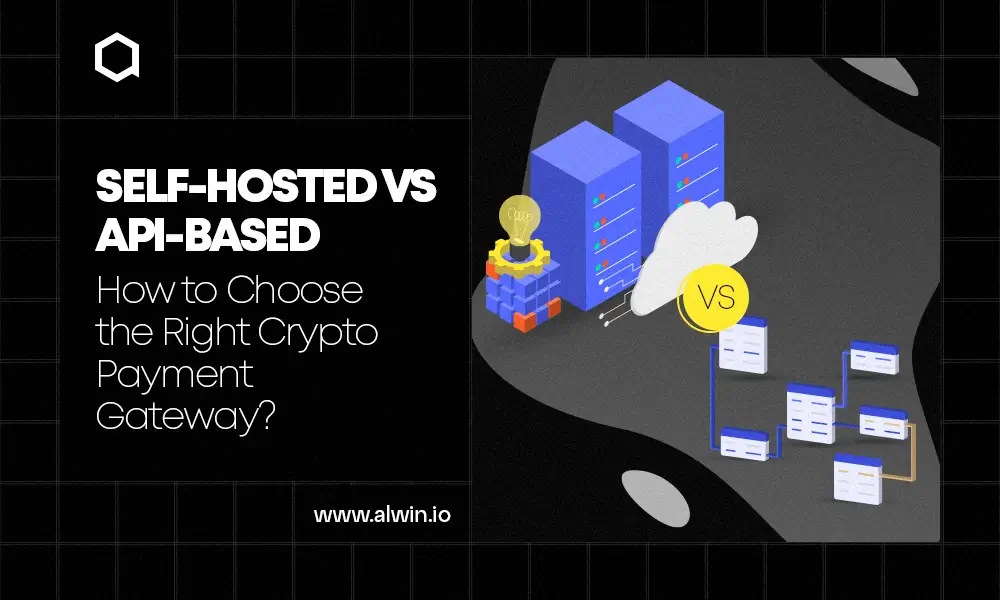Thinking about accepting crypto payments for your business or Web3 project? Great move! But before you dive in, there’s one big decision to make should you go with a self-hosted crypto payment gateway or use an API-based solution?
Both options let you accept digital currencies like Bitcoin, Ethereum, and stablecoins, but they work in totally different ways. One gives you full control (and responsibility), while the other offers convenience and speed—but with a few trade-offs.
If you're confused about which path to take, you're not alone. Choosing the right payment setup can affect everything from your transaction fees and user experience to compliance, scalability, and security. In this blog, we’ll break down the pros, cons, and real-world use cases of each approach—so you can make a decision that’s not just smart, but strategic. Let’s get into it!
What is a Payment Gateway?
A payment gateway is a technology that acts as a bridge between a customer and a business, allowing money to move securely from the buyer’s account to the seller’s account during an online transaction. It collects, encrypts, and transfers payment data—such as credit card details or crypto wallet information—so that transactions can be processed safely and efficiently. Whether it's a traditional e-commerce platform or a blockchain-based application, the payment gateway plays a crucial role in ensuring trust, speed, and accuracy in digital payments.
In simple terms, think of a payment gateway as the digital version of a card swipe machine—but for online and mobile purchases. It works silently in the background to authorize payments, check for fraud, and complete the transfer all in a matter of seconds. Without it, businesses wouldn’t be able to sell online, and customers wouldn’t have a secure way to pay.
Real-Life Example-
Imagine you run a digital art store and want to accept Bitcoin or USDT. You integrate a crypto payment gateway into your site. When a customer wants to buy, the gateway provides a wallet address or QR code, handles the transaction on the blockchain, confirms it, and updates your store with the payment status.
Without a payment gateway, you can’t process secure online payments. It’s essential for e-commerce, SaaS platforms, NFT marketplaces, donation sites—any place where digital transactions happen. Whether you’re dealing in dollars or Dogecoin, the gateway is the bridge between your customer and your business.
How do Payment Gateways Work?
A payment gateway works by securely transferring payment information between the customer, the business, and the bank or blockchain network. Whether it’s a traditional card payment or a crypto transaction, the goal is the same: ensure that money moves safely from the buyer to the seller. Here's how the process works, step by step:
Step 1: Customer Initiates Payment
The process begins when a customer decides to make a purchase. They go to the checkout page and select their preferred payment method—this could be a credit/debit card, net banking, digital wallet, or cryptocurrency.
Step 2: Payment Details Are Entered
The customer fills in their payment details, such as card number, CVV, expiration date, or crypto wallet address. This information is then sent to the payment gateway for processing.
Step 3: Data Is Encrypted and Sent for Authorization
The payment gateway encrypts the sensitive data to protect it from fraud or hacking. It then forwards the encrypted data to the payment processor or acquiring bank, which routes it to the card network (like Visa, Mastercard) or the crypto network (like Bitcoin, Ethereum).
Step 4: Bank or Network Verifies the Transaction
The issuing bank (the customer’s bank) or blockchain verifies if the customer has sufficient balance or crypto in their wallet. It checks for red flags like fraud or expired credentials, and either approves or declines the transaction
Step 5: Authorization Response Sent Back
The result (approved or declined) is sent back through the same channel—from the network or bank, through the payment processor, and finally back to the payment gateway. The customer sees the message instantly: “Payment Successful” or “Payment Failed.”
Step 6: Funds Are Transferred to the Merchant
If the payment is approved, the funds are settled. In traditional payments, this may take a day or two to reflect in the business’s account. In crypto, the transfer can happen much faster depending on the network used.
Step 7: Transaction Complete
The merchant receives confirmation, the order is processed, and the customer gets a receipt. Behind the scenes, the payment gateway has handled all the communication securely and efficiently, often in just a few seconds.
What are the Different Types of Payment Gateways?
A payment gateway acts as the bridge between a customer’s payment method and a business’s bank account. But not all payment gateways are built the same. Depending on your business model, industry, and level of control needed, you can choose from several different types of payment gateways. Here’s a breakdown of the most common types:
Hosted Payment Gateway
Self-Hosted Payment Gateway
API-Based Payment Gateway
Local Bank Integration Gateway
Cryptocurrency Payment Gateway
Mobile Payment Gateway
Choosing the Right Type
The right payment gateway depends on your:
Target audience (tech-savvy, mobile users, crypto investors, etc.)
Geographic reach (global vs. local)
Transaction volume and risk
Need for customization vs. simplicity
Each type of payment gateway comes with its own strengths. The key is to choose the one that aligns with your business goals, technical resources, and customer expectations.
Self-Hosted or API-Based Crypto Payment Gateways: Which One is Better?
If you’re looking to accept cryptocurrency payments on your platform, one of the first decisions you’ll face is whether to use a self-hosted crypto payment gateway or an API-based solution. Both offer the ability to receive payments in crypto, but they differ significantly in terms of control, flexibility, cost, and technical responsibility.
Let’s explore each option in depth to help you decide what’s right for your business.
What is a Self-Hosted Crypto Payment Gateway?
A self-hosted crypto payment gateway is a fully managed payment system that you deploy on your own server or infrastructure. This means your platform handles everything—from generating wallet addresses to processing blockchain transactions, verifying confirmations, and logging data.
Advantages:
Full Control Over Transactions
Since everything runs on your server, you decide how to process payments, how wallets are generated, how data is stored, and how users interact with the payment system.
Customization Flexibility
You can modify every element—from user interface to transaction flow—to match your brand and business model. You can even add your own logic for crypto conversions, discounts, token rewards, etc.
No Third-Party Fees or Dependency
There are no transaction fees charged by a third-party gateway, and you won’t be affected by another company’s policies, limits, or service downtime.
Challenges:
Requires Technical Expertise: Self-hosting a gateway requires blockchain knowledge, server setup, wallet management, and experience with smart contracts. It’s not beginner-friendly.
You Handle Security & Compliance
You are responsible for encrypting user data, storing private keys, and complying with local regulations like KYC/AML. This can be risky without proper setup.
Higher Initial Cost: You’ll need developers, hosting infrastructure, and ongoing maintenance, which could lead to higher upfront costs compared to plug-and-play services.
Best For:
Tech-savvy businesses, blockchain projects, DeFi platforms, enterprises looking for data ownership and long-term scalability.
What is an API-Based Crypto Payment Gateway?
An API-based crypto gateway is provided by third-party services like Coinbase Commerce, NOWPayments, BitPay, or CoinPayments.net. These platforms offer APIs you can integrate into your website or app to start accepting crypto payments instantly.
Advantages:
Quick and Easy Integration
Most APIs come with clear documentation and SDKs, allowing you to integrate them into your platform within hours or days—no blockchain experience required.
Security & Compliance Taken Care Of
The service provider handles all backend logic, wallet generation, blockchain confirmations, and data security. They also ensure the platform is KYC/AML compliant, removing that burden from your business.
Built-In Features
You often get dashboards, auto-conversion to fiat, invoice generation, real-time transaction updates, and multi-coin support—all out of the box.
Challenges:
Limited Customization: Since you're using someone else’s system, you’re restricted by what their API supports. You can’t change how wallets are created or how funds are routed.
Dependency on Third-Party Uptime: If the service goes down or is restricted in your region, your payment process could be impacted. You’re relying on their reliability and service terms.
Transaction Fees: Most API providers charge per transaction or offer tiered subscription pricing, which may add up as your volume grows.
Best For:
Startups, eCommerce businesses, creators, and non-technical entrepreneurs who want fast access to crypto payments without the burden of managing infrastructure.
Final Verdict: Which Should You Choose?
Choose a self-hosted crypto payment gateway if you want complete control, full branding freedom, and data ownership, and if you have the technical resources to manage it.
Choose an API-based crypto payment gateway if you want to go live quickly, reduce your workload, and focus more on business than infrastructure—perfect for getting started or handling smaller volumes.
Ultimately, there’s no one-size-fits-all solution. It comes down to your business goals, technical capacity, and how much control you’re ready to take on. Some businesses even start with API-based solutions and migrate to self-hosted gateways as they grow.
Both paths lead to success—it’s just about choosing the one that fits your journey best.



